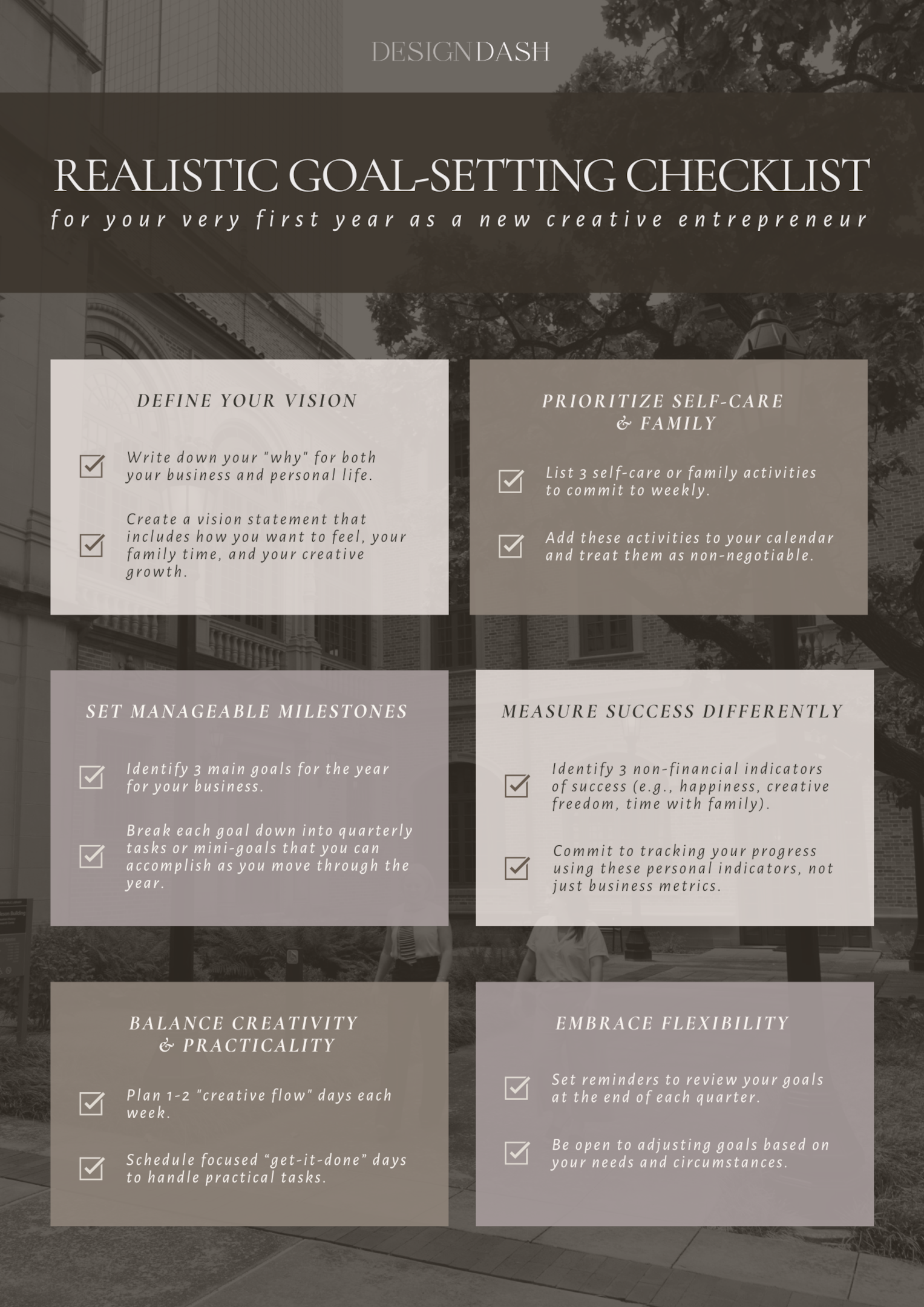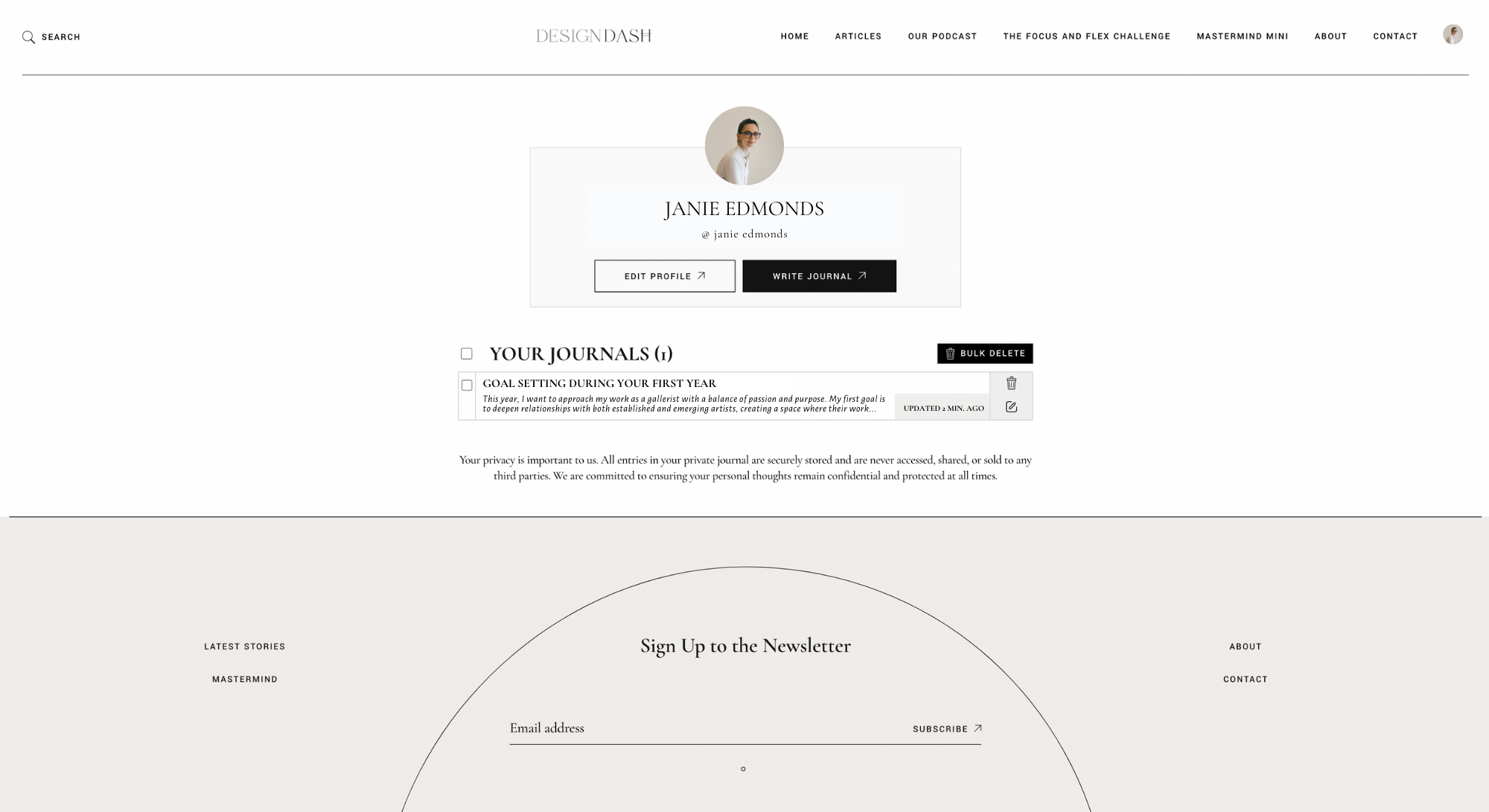

DesignDash Guide to Setting Realistic Goals for Your First Year as an Entrepreneur
Summary
Setting realistic goals in your first year as an entrepreneur is key to finding balance between your business and personal life. This guide walks creative entrepreneurs through various goal-setting methods, including SMART goals, OKRs, and process-oriented goals, and offers actionable tips on breaking goals into manageable milestones, balancing creativity and practicality, prioritizing self-care, and measuring success beyond financial metrics. The journey is just as important as the destination—embrace growth, stay flexible, and celebrate your progress along the way.
Reflection Questions
- What personal values do you want your business goals to reflect, and how can they help guide your decisions this year?
- How do you balance the creative and practical sides of your business, and where can you create more space for both?
- What non-financial indicators of success resonate most with you, and how will you measure them throughout the year?
Journal Prompt
Reflect on what success looks like for you, both personally and professionally, one year from now. Write down your “why” and how you envision your business contributing to the life you want to create. What specific steps can you take to ensure that your goals align with your values and support both your business growth and personal well-being?
Between running your business, staying creatively inspired, and making time for family, it’s easy to feel stretched thin. Setting goals that actually fit into your life without pushing you toward burnout is key to thriving in this first year. There’s beauty in starting something new, filled with hope and possibility, but success doesn’t come from perfection—it comes from growth. With actionable tips and free downloads, our guide will help you craft realistic goals that inspire you without overwhelming you. Let’s set the foundation for a fulfilling year that honors both your creativity and your need for balance. Read on for all of our top goal-setting tips that prioritize your personal growth while supporting the steady development of your professional life.
Different Approaches to Goal-Setting


Before we dive into the goal-setting process, let’s explore a few methods for setting meaningful goals you can actually achieve. When it comes to setting goals (whether professional or personal goals), there’s no single best approach—what works for one person may not work for another. Below are a few popular methods for goal-setting that go beyond the standard SMART framework so you can find the one that fits your unique personality and needs.
SMART Goals
SMART goals are one of the most popular goal-setting methods for a reason—they’re highly actionable and easy to measure. The SMART goal acronym stands for Specific, Measurable, Achievable, Relevant, and Time-bound. By setting goals that meet each of these criteria, you create a clear roadmap for success.
For example, instead of setting a vague goal like “Grow my business,” you might say, “Increase online sales by 20% in the next quarter by focusing on email marketing and social media campaigns.” SMART goals are great for breaking goals down into manageable tasks, keeping you accountable, and tracking progress in a concrete way, making them ideal if you prefer structure and clear deadlines. Setting achievable goals makes all the difference when it comes to actually making progress, and the SMART method helps you do that.
OKRs (Objectives and Key Results)


OKRs are popular among entrepreneurs and businesses that want to stretch beyond just meeting basic goals. With OKRs, you set one overarching objective—something that inspires and challenges you—and then identify key results that help you measure your progress toward that objective.
For example, if your objective is to “Build a loyal community around my brand,” your key results might include “Increase social media engagement by 15%,” “Gain 5,000 newsletter subscribers,” and “Host three community events by the end of the year.” OKRs allow you to keep your focus on the big picture while also breaking it down into measurable steps.
The HARD Goals Framework
If you’re someone who needs your goals to feel deeply meaningful and challenging, HARD goals might resonate with you. HARD stands for Heartfelt, Animated, Required, and Difficult. This approach focuses on challenging goals that are emotionally connected to your purpose (Heartfelt), vividly imagined (Animated), essential for your success (Required), and ambitious enough to push you (Difficult).
For example, if you’re passionate about launching a brand that promotes sustainability, your HARD goal might be, “Design and launch a 100% sustainable product line by the end of the year.” This method works well for entrepreneurs who thrive on passion and need goals that align with their deeper values. It’s not the best for weekly goals, but it’s perfect for big-picture annual planning.
Process-Oriented Goals


While most goal-setting methods focus on outcomes, process-oriented goals shift the focus to the habits and actions you take daily. Instead of focusing on what you want to achieve, you focus on the steps that will lead you there.
For example, instead of setting a goal to “Grow my email list to 10,000 subscribers,” a process-oriented goal might be “Spend 30 minutes each day writing content for my newsletter.” This approach is ideal for creatives who thrive in routines and prefer to emphasize progress through daily or weekly habits rather than fixating on distant end results. Process-oriented goals are also helpful in reducing overwhelm, as they encourage you to focus on what you can control each day.
Stretch Goals
Stretch goals are ambitious, audacious goals that push you beyond your comfort zone. These goals are designed to inspire you to think big and aim higher than you normally would. For instance, if your current client base is 50 customers, a stretch goal might be, “Double my client base in the next year.” While this goal may feel out of reach, the purpose of stretch goals is to drive innovation and growth.
By aiming higher, you’ll likely find yourself exploring new strategies and creative solutions that you wouldn’t have considered if you’d set a more modest goal. Stretch goals are perfect for entrepreneurs who are comfortable with risk and motivated by challenge.
Values-Based Goals


If you want to ensure that your goals align with your personal values and what matters most to you, values-based goal setting is a great approach. This method encourages you to reflect on your core values—whether it’s creativity, family time, or making an impact—and set goals that reflect those priorities.
For example, if family time is a top priority, a values-based goal might be, “Work no more than 30 hours a week so I can spend evenings with my family.” This approach helps ensure that your business supports your personal life and allows you to stay true to your vision of success. It’s perfect for those who want their goals to be a reflection of their whole self, not just their professional ambitions.
The DesignDash Guide to Goal Setting for Your First Year as a Business Owner


Setting actionable goals is about so much more than just business growth—it’s about building a life that reflects your values, passions, and personal priorities. Now that we’ve talked about the different ways to set goals, it’s time to walk you through actionable steps to define your big-picture vision, break down your goals into manageable milestones, and create a path that allows you to thrive both professionally and personally. This approach ensures that your business supports your life, not the other way around, so you can grow sustainably and overcome challenges without burning out. Let’s start with envisioning what success truly means to you.
Part 1: Define Your Big Picture Vision
Reflection Prompt: What does success look like for you, not just in business but in life?
As a creative entrepreneur, success is not just about hitting revenue targets or building a thriving business. It’s about crafting a life that feels fulfilling on all fronts—where your creativity has room to grow, your relationships are nourished, and you can truly enjoy the fruits of your labor.
Take a moment to reflect on what success means for you personally. Does it involve more flexibility in your schedule, so you can spend time with loved ones? Is it about creating a business that aligns with your values and allows you to feel fulfilled at the end of the day? This reflection will help shape your goals in a way that brings harmony to both your personal and professional life.


Write down your answer in your DesignDash Journal. Be sure to create an account with us to type entries for each article you read. Don’t worry—it’s completely confidential.
Hot Tip
Think beyond numbers—focus on how you want to feel, how much time you want to spend with family, or how your work will evolve over time. It’s easy to get caught up in measurable goals like growing your client base or hitting a certain financial milestone. While those are important, it’s just as crucial to consider how you want to feel as you achieve them.
Do you want to feel more balanced, creatively energized, or connected to your family and community? Perhaps you envision a future where you have more time to travel or invest in passion projects. When you set goals with these feelings in mind, you’ll create a framework that’s both motivating and sustainable, allowing you to pursue your dreams without compromising your well-being.
Fuel your creative fire & be a part of a supportive community that values how you love to live.
subscribe to our newsletter
*please check your Spam folder for the latest DesignDash Magazine issue immediately after subscription


Action Step
Write down your “why” and vision for both your business and personal life. Now that you’ve reflected on your big picture vision, it’s time to put it into words. Write down your “why”—the core reason you started your business in the first place. Then, take it a step further by mapping out your vision not only for your business but for your personal life, too.
What does an ideal day look like for you a year from now? How does your business contribute to the life you want to live? By getting clear on this, you’ll have a guiding star for the decisions you make in your first year, ensuring that every step you take brings you closer to the life you truly desire.
Part 2: Break Down Goals Into Manageable Milestones


When you start a business, it’s easy to get caught up in big, long-term goals that can feel overwhelming and distant. Instead, focusing on smaller, bite-sized goals can create momentum and a sense of accomplishment along the way. Each small win builds confidence, keeps you motivated, and reminds you that progress is happening—even on the busiest days. Small goals are the stepping stones that help you see the path clearly, keeping you energized without losing sight of your bigger vision. Celebrating these wins, no matter how small, is key to staying motivated and avoiding burnout.
Hot Tip
Focus on monthly or quarterly goals rather than overwhelming yourself with one-year plans. Breaking your goals into monthly or quarterly chunks makes them feel more achievable and allows you to adjust your plans as needed. Rather than trying to predict everything that will happen in the next 12 months, focus on what’s within reach over the next few weeks or months.
This approach gives you flexibility and space to adapt while maintaining forward momentum. Think of it as a series of sprints rather than a marathon—it’s easier to measure progress and celebrate your successes when you can see results more quickly. Plus, shorter goals help you stay nimble, which is essential in the fast-paced world of entrepreneurship.
Action Step
Now, let’s make your big picture vision actionable. Start by identifying three main goals that you want to accomplish in your first year. These could be related to growing your client base, building your brand, or achieving a work-life balance.
Once you’ve set these goals, break each specific goal down into manageable tasks you can complete each quarter. For example, if one of your goals is to launch a website, your quarterly tasks might include outlining content in Q1, building the site in Q2, and launching it in Q3. This structured approach keeps you focused and ensures steady progress throughout the year.
Part 3: Balancing Creativity and Practicality


Creativity flourishes when you give it room to breathe, but it also needs structure to thrive. As a creative entrepreneur, your ideas are the lifeblood of your business. However, creativity can’t thrive in chaos—it needs balance. Just as a plant needs sunlight and water, creativity needs freedom and structure.
Giving yourself space to dream big is essential, but pairing that with the discipline to execute your ideas is where the magic happens. Without structure, those inspiring ideas can get lost, and without creativity, structure becomes stifling. Finding that balance is key to keeping both your creativity and your business thriving.
Hot Tip
Alternate between “big picture” creative days and more practical “get-it-done” days to balance vision and action. To keep your creative energy alive while also making sure your business moves forward, try alternating between days where you focus on vision and days dedicated to execution. On creative days, let yourself dream, brainstorm, and explore new ideas without pressure.
On practical days, focus on the tasks that bring those ideas to life—whether it’s managing finances, responding to emails, or completing projects. This rhythm allows you to indulge in your creative flow while also keeping the gears of your business turning smoothly.
Action Step
Set a weekly schedule that honors both your creative flow and business needs. Take a moment to plan out your week in a way that respects both your creative impulses and your practical business needs. Set aside specific days or blocks of time for brainstorming, designing, or problem-solving, and balance that with dedicated time for administrative tasks or meetings.
This way, you can dive deep into your creative work without feeling like you’re neglecting your responsibilities. Make sure your schedule reflects this balance so that both parts of your business—and your mind—get the attention they need.
Part 4: Prioritizing Self-Care and Family Time


Your ability to create, innovate, and grow as a business owner is directly linked to how well you take care of yourself. Mental and physical well-being are not luxuries—they are essential for fueling your creativity. When you’re constantly running on empty, it becomes harder to come up with fresh ideas, stay motivated, or even enjoy the process. Prioritizing self-care and time with loved ones recharges your batteries, providing the clarity and energy needed to be fully present in your work.
Hot Tip
Schedule in family time, self-care, and rest with the same dedication as business tasks. Just as you carefully plan your workdays, it’s important to schedule self-care and family time. Block out time in your calendar for activities that nourish your mind and body, whether it’s taking a walk, reading, having dinner with family, or just resting. By treating self-care and family time as non-negotiable appointments, you’re building in the space to reset and refuel, which ultimately helps sustain your creative energy and long-term productivity.
Action Step
Take a moment to write down three self-care or family activities that you’ll prioritize each week. These could be as simple as setting aside time for a relaxing bath, spending an hour doing yoga, or planning a weekend hike with your family.
Once you’ve identified these activities, add them to your calendar, and treat them with the same importance as your work commitments. This ensures you are nurturing both your personal life and creative spirit.
Part 5: Avoiding Burnout—Embrace Flexibility


Goals can be flexible—progress isn’t linear, and that’s okay. One of the biggest challenges of entrepreneurship is learning to accept that progress isn’t always a straight line. Life happens, plans change, and sometimes, goals need to shift.
Flexibility is a strength, not a weakness, and allowing yourself to adjust your path when needed can help prevent burnout. Remember, your goals are a guide, not a strict rule. Embracing the ebb and flow of progress keeps you resilient and ensures that you stay aligned with what truly matters to you.
Hot Tip
Allow room for adjustments when life gets in the way, and remember that shifting a goal doesn’t mean failure. Things won’t always go according to plan—and that’s okay. Allow yourself the grace to adjust your goals when needed, whether it’s because of unforeseen challenges or shifting priorities.
Adjusting a deadline or scaling back a project isn’t a sign of failure; it’s a necessary part of staying sustainable and balanced. Remember, the ultimate goal is to keep moving forward in a way that works for you, not to meet arbitrary deadlines that no longer serve your well-being or business.
Action Step
Revisit your goals at the end of each quarter to make any necessary changes. Set a reminder to review your goals at the end of each quarter. Reflect on what’s working, what’s changed, and whether any adjustments are needed. This regular check-in helps you stay on track while giving you the freedom to pivot as life or business evolves. By reviewing and tweaking your goals periodically, you can stay flexible while ensuring you’re always moving forward.
Part 6: Measuring Success Beyond Metrics


Reflection Prompt: What does success mean to you in a more personal, emotional sense?
Success is often measured in numbers, but for creative entrepreneurs, it’s important to look beyond the metrics and consider what truly fulfills you. Take a moment to reflect: How do you want to feel at the end of a successful day or project? What gives you a sense of pride, joy, or peace?
Success could be the satisfaction of seeing a creative idea come to life, the freedom to spend more time with family, or the excitement of making a positive impact through your work. Defining success in personal and emotional terms will help you create a more meaningful and balanced business journey.
Hot Tip
Don’t just measure your success in financial growth—consider happiness, fulfillment, and creative freedom. While financial growth is important, it’s only one piece of the puzzle. As you track your progress, make sure to also measure success in terms of happiness, fulfillment, and creative freedom.
Are you enjoying the work you’re doing? Are you finding time for the things that matter most to you? These intangible indicators are just as important, if not more, than numbers on a spreadsheet. By keeping these personal measures of success in mind, you’ll ensure that your business aligns with your broader vision of a fulfilling life.
Action Step
Create a list of non-financial success indicators that resonate with your long-term vision. Take time to identify and write down non-financial success indicators that are meaningful to you. These could include things like work-life balance, creative freedom, time spent with loved ones, or personal growth.
Keep this list somewhere visible, and refer to it regularly as you set and evaluate your goals. By measuring success holistically, you’ll stay grounded in what truly matters and avoid getting lost in the pursuit of numbers alone.
Final Thoughts on Goal Setting as a Creative


It’s so easy to feel like success is linear and defined. But success isn’t just about checking off every goal on your list—it’s about learning, evolving, and embracing the journey. Each step you take, whether it’s a small win or a moment of readjustment, is a part of your growth.
Setting realistic goals is about creating a sustainable and fulfilling path, allowing your business to grow alongside your life, not at its expense. Celebrate your progress, stay flexible, and always keep your vision in focus. When you’re building something incredible, the journey is just as important as the destination.









